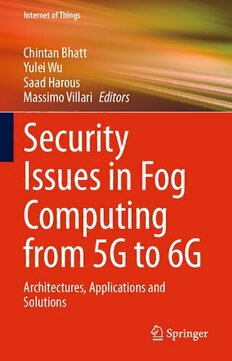Table Of ContentInternet of Things
Chintan Bhatt
Yulei Wu
Saad Harous
Massimo Villari Editors
Security
Issues in Fog
Computing
from 5G to 6G
Architectures, Applications and
Solutions
Internet of Things
Technology, Communications and Computing
SeriesEditors
GiancarloFortino,Rende(CS),Italy
AntonioLiotta,EdinburghNapierUniversity,SchoolofComputing,Edinburgh,UK
The series Internet of Things - Technologies, Communications and Computing
publishesnewdevelopmentsandadvancesinthevariousareasofthedifferentfacets
oftheInternetofThings.
The intent is to cover technology (smart devices, wireless sensors, systems),
communications(networksandprotocols)andcomputing(theory,middlewareand
applications) of the Internet of Things, as embedded in the fields of engineering,
computer science, life sciences, as well as the methodologies behind them. The
series contains monographs, lecture notes and edited volumes in the Internet of
Things research and development area, spanning the areas of wireless sensor net-
works,autonomic networking, network protocol,agent-based computing, artificial
intelligence, self organizing systems, multi-sensor data fusion, smart objects, and
hybridintelligentsystems.
**Indexing:InternetofThingsiscoveredbyScopusandEi-Compendex**
Chintan Bhatt • Yulei Wu • Saad Harous •
Massimo Villari
Editors
Security Issues in Fog
Computing from 5G to 6G
Architectures, Applications and Solutions
Editors
ChintanBhatt YuleiWu
DepartmentofComputerScienceand DepartmentofComputerScience,College
Engineering,SchoolofTechnology ofEngineering,MathematicsandPhysical
PanditDeendayalEnergyUniversity Sciences
Gandhinagar,Gujarat,India UniversityofExeter
Exeter,UK
SaadHarous MassimoVillari
ComputerSciencesDepartment Dip.diIngegneriaCivile
UniversityofSharjah Universita’diMessina
Sharjah,UnitedArabEmirates Messina,Italy
ISSN2199-1073 ISSN2199-1081 (electronic)
InternetofThings
ISBN978-3-031-08253-5 ISBN978-3-031-08254-2 (eBook)
https://doi.org/10.1007/978-3-031-08254-2
©TheEditor(s)(ifapplicable)andTheAuthor(s),underexclusivelicensetoSpringerNatureSwitzerland
AG2022
Thisworkissubjecttocopyright.AllrightsaresolelyandexclusivelylicensedbythePublisher,whether
thewholeorpartofthematerialisconcerned,specificallytherightsoftranslation,reprinting,reuse
ofillustrations,recitation,broadcasting,reproductiononmicrofilmsorinanyotherphysicalway,and
transmissionorinformationstorageandretrieval,electronicadaptation,computersoftware,orbysimilar
ordissimilarmethodologynowknownorhereafterdeveloped.
Theuseofgeneraldescriptivenames,registerednames,trademarks,servicemarks,etc.inthispublication
doesnotimply,evenintheabsenceofaspecificstatement,thatsuchnamesareexemptfromtherelevant
protectivelawsandregulationsandthereforefreeforgeneraluse.
Thepublisher,theauthors,andtheeditorsaresafetoassumethattheadviceandinformationinthisbook
arebelievedtobetrueandaccurateatthedateofpublication.Neitherthepublishernortheauthorsor
theeditorsgiveawarranty,expressedorimplied,withrespecttothematerialcontainedhereinorforany
errorsoromissionsthatmayhavebeenmade.Thepublisherremainsneutralwithregardtojurisdictional
claimsinpublishedmapsandinstitutionalaffiliations.
ThisSpringerimprintispublishedbytheregisteredcompanySpringerNatureSwitzerlandAG
Theregisteredcompanyaddressis:Gewerbestrasse11,6330Cham,Switzerland
Foreword
Computing architectures and services experienced a great revolution in the last
two decades, mostly based on the innovation brought forward by more and more
sophisticated virtualization technologies and by the consequent evolution of the
cloud computing paradigm. Cloud computing, together with the evolution of the
terminals (smartphones, tablets, wearable devices, etc.), changed the way we use
digitalapplicationsthatnowbringtoourhandscomplexservicesandapplications
whosecomputationismostlyoffloadedtosomeremotecloudinfrastructure.
Nonetheless,thisapproachhaslimitswhenitcomestoperformanceissuessuch
aslowlatencybecauseoftheinherenttimeneededtoreachdatacentersthatmaybe
veryfaraway.Themostobvioussolutionistobringthecomputationclosertothe
enduser.Thisisthemotivationbehindthehighinterestinfogandedgecomputing
ofthelastyears.Executingthecomputationthatwillproducetheresultsrelevantto
aserviceascloseaspossibletotheconsumermayappearquiteobvioustoreduce
latencyandimproveresponsivenessofapplications,butitisalsoverychallenging
fromthetechnicalpointofview.
There is no one-size-fits-all answer to this problem, the technical solutions are
manyandaretypicallydependentonthespecificapplicationdomain.Moreover,this
approachopensthefloortoawholesetofsecuritychallenges,relatedtotheinherent
distributionofcomputationandofinformationsharing.Therefore,dealingwithfog
computing solutions requires a careful investigation of the related cybersecurity
challengesandpossiblecountermeasures.
Thisbookofferstothereaderaseriesofspecificchaptersthataimatproviding
answerstotheseproblems.Itstartsbygivinganoverviewofthechallengesandmost
studied solutions forfogcomputing. Itthen focuses on thenetwork infrastructure,
mobilenetworksconsidering5Gcurrentlyunderdevelopmentorthefuture6G,as
wellashigh-performanceopticalapplications.Supportingfogcomputingscenarios
is challenging for the network, and the chapters on these topics analyze these
problems and provide possible solutions. Finally, the book provides insights into
specific vertical domains, from medical applications to sensing and Internet of
Things applications. In all these scenarios, the problem of trust and information
v
vi Foreword
reliabilityisofparamountimportance,andthefocusofseveralchaptersofthebook
isonthepossibleexploitationoftheblockchaintechnology.
I believe that Security Issues in Fog Computing from 5G to 6G will be useful
to readers who are starting to approach this complex technical topic, since it puts
together many different perspectives, application examples, and specific solutions.
Atthesametime,itwillbeausefulreferenceforthemoreexperiencedresearcher
whoaimsatgoingdeeperintoaspecificverticalapplicationoffogcomputingand/or
blockchain,orwholooksforpossibleopenquestionsand/orfutureresearchtopics
tobeexplored.
AlmaMaterStudiorum–UniversitàdiBologna, FrancoCallegati
DepartmentofComputerScienceandEngineering,
Cesena,Italy
Preface
The fog/edge computing paradigm has been widely adopted for improving the
agility of service deployments, allowing for the use of opportunistic and cheap
computing resources that can be used to take advantage of network latency and
bandwidth diversities among such resources. There are a lot of challenges when
it comes to using fog/edge resources, and it is important to revisit operating
systems, virtualization and container technologies, and middleware techniques for
fabric management in order to address these challenges. We need new ways of
programmingandstoringdatainordertocreateinnovativeapplicationsthatcantake
advantageofmassivedistributedanddata-drivenfog/edgesystems.Theintegration
offog/edgecomputingand5G,aswellasmachineand/ordeeplearning,willbring
new opportunities and challenges for many emerging applications and domains,
such as autonomous vehicles and intelligent health. It is of paramount importance
toaddresssecurity,privacy,andtrustissuesinfog/edgecomputing,whilemanaging
theresourcesandcontextofmobile,transient,andhardware-constrainedresources.
Thisbookentailstenchapters,includingthefollowingstudies.
InChap.1,SeemaandShaileshaimedtosystematicallyandstatisticallyclassify
andanalyzevariouswell-knownsecuritychallengesandattacksforthefogenabled
Internet of Things (IoT) and Industrial IoT (IIoT) environment. In addition, the
authorshaveconsideredthe“trust”componentinthisstudyandexaminedvarious
securityissues.
InChap.2,Jinarajadasaetal.highlightedhowevolutionarymethodsavailablein
computationalintelligencecanbeappliedtoovercometheissuesofmobileadhoc
networksintermsofsecurityandreliablecommunications.
In Chap. 3, Anusha et al. presented a detailed study of this fusion of fog
computing with the blockchain technology for achieving the goal of increased
security.
Alessandro,inChap.4,investigatedthechallengesandpossibilitiesofwireless
communications in fog computing. In particular, the authors examined the advan-
tagesofadoptingphysicallayersecurity(PLS)techniques.
InChap.5,BadidiandSabirproposedtheblockchain-basedarchitecture,which
servesasaplatformforsecuredatastorageanddatasharinginasmartcity.
vii
viii Preface
Chapter6revealedthebenefitsofintegratingmoderntechnologies(fogcomput-
ing,blockchain,6G,andIoT)tosolvetheproblemofmicropaymentsystems.Jamal
etal.highlightedthevariousrelationshipsamongthesetechnologiesandsurveyed
the most relevant work to analyze how these disruptive technologies can improve
themicropaymentsystem’sfunctionality.
In Chap. 7, Kakulapati et al. showcased a solution using one of the most
prominent characteristics, that is, traceability, using which we can back-trace
the route taken in the supply chain for the targeted drug on which the medical
prescriptionismade.
ThemainobjectiveofChap.8wastoprovideadigitalidentityandanonymous
accessauthenticationmechanismbasedonblockchain,becauseofthedataisolation
probleminthenetwork.Theauthorsproposedatrustedmulti-domaincooperation
mechanismbasedonblockchain.
Chapter 9 introduced the fog computing architecture and critical features for
IoT networks. Harbi and the co-authors presented typical applications of the fog
computing paradigm in the context of IoT and provided a classification of these
applications.
Chapter10isallaboutconcludingremarks,writtenbySidath.
This book is designed for researchers, engineers, and developers working in
the fields of fog computing with emerging technologies like 5G and blockchain.
Practitionerswhoconductteachingandcutting-edgeresearchinsecureIoTandfog
environmentswillbebenefitedfromthisbook.
Specialthankstoallcontributors,respectedreferees,andourpublisher,Springer.
Gandhinagar,Gujarat,India ChintanBhatt
Exeter,UK YuleiWu
Sharjah,UAE SaadHarous
Messina,Italy MassimoVillari
Contents
1 ASystematicSurveyonSecurityChallengesforFog-Enabled
InternetofThings(IoT)andIndustrialInternetofThings(IIoT).... 1
SeemaB.JoshiandShaileshkumarD.Panchal
2 EvolutionaryAlgorithmsforEnhancingMobileAdHoc
NetworkSecurity........................................................... 15
G.M.JinarajadasaandS.R.Liyanage
3 Blockchain-BasedFogComputing........................................ 31
AnushaVangalaandAshokKumarDas
4 Physical Layer Security Challenges and Solutions for
Beyond5GFogComputingNetworks.................................... 59
AlessandroBrighente,MauroConti,andForooghMohammadnia
5 BlockchainforSecureDataSharinginFog-BasedSmart
CitySystems................................................................. 79
ElarbiBadidiandEssaidSabir
6 IntegratingBlockchainwithFogandEdgeComputingfor
MicropaymentSystems .................................................... 93
JamalAl-Karaki,DeepaPavithran,andAmjadGawanmeh
7 MedicalPrescriptionTraceabilityUsingBlockchain-Based
DecentralizedApplication ................................................. 113
V.KakulapatiandParimiShivaKalyan
8 OpticalandWirelessConvergenceNetworkBasedonBlockchain... 131
HuiYang
9 FogComputingSecurityandPrivacyforInternetofThings
(IoT)andIndustrialInternetofThings(IIoT)Applications:
StateoftheArt.............................................................. 145
YasmineHarbi,ZiboudaAliouat,andSaadHarous
ix

